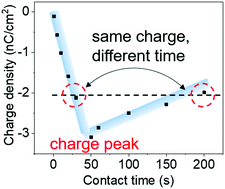Irreproducibility in the triboelectric charging of insulators: evidence of a non-monotonic charge versus contact time relationship†
Abstract
Here, we investigate the development and relaxation of static charges on the surface of plastic materials that are first brought in contact, and then macroscopically separated. Experimentalists dealing with the static electrification of insulators are aware of difficulties predictably attaining, and precisely reproducing, a given charging magnitude. Here we have observed for the first time that in homo-systems (e.g. PTFE rubbed against PTFE) charge densities reach the maximum value after a material-specific contact time. Attempts to charge a sample beyond its peak value leads to a progressive drop in charge. We propose this drop to result both from the electrostatically driven segregation of polymer ionic fragments, as well as from the discharge of unstable fragments by dielectric breakdown when a sufficiently high surface charge density is reached. We therefore highlight the general existence of two branches in the charging versus charging time curve: the assumption of a monotonous charging slope holds only left or right of the charging maxima and to achieve a specific charge density, care has to be taken to remain within one branch. Differences between materials in the tribocharging peak time are shown to reflect difference in material transfer rates and water adsorption, rather than differences in electronic factors such as the relative stability of cationic and anionic fragments.



 Please wait while we load your content...
Please wait while we load your content...